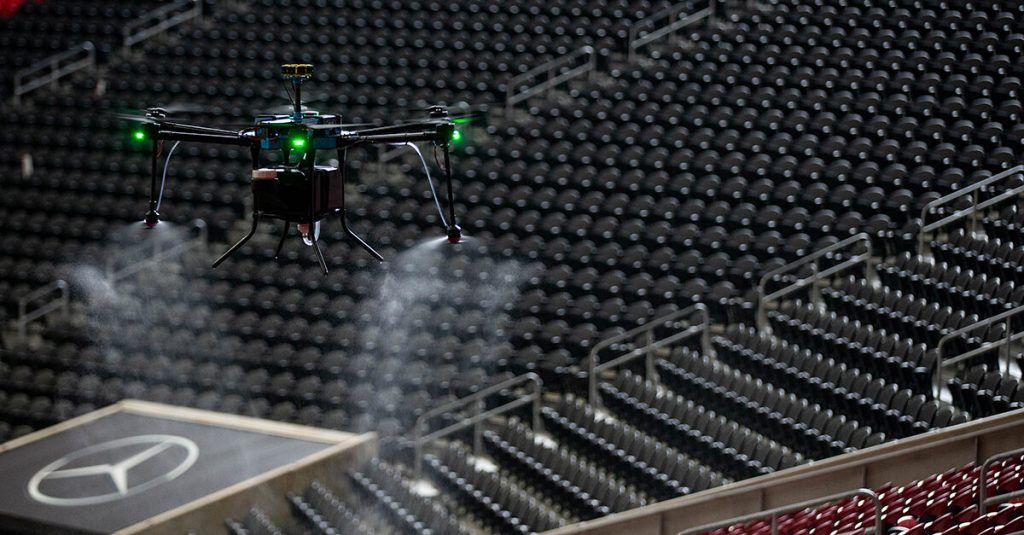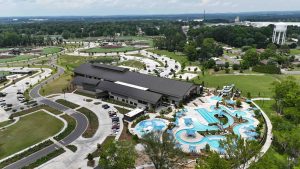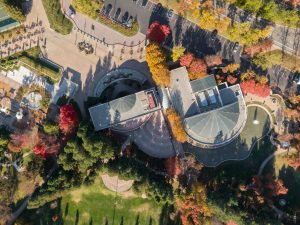Guest post written by Johnny Crosskey, SEO & Content Specialist, The Sports Facilities Companies.
If you have traveled to a local park or greenspace recently, you’ve likely seen drones in action. You may also know that what was once a cool techie toy has surged in operational outlets. Drones captivate video audiences with sweeping landscape shots. They are a nimble “eye in the sky” for everything from farmers who need to monitor crops to emergency rescue crews on search and recovery missions. However, within the emergence of the COVID-19 pandemic, they took on a new operational task assignment. Companies were already using drones as a more efficient and safe solution to cleaning elevated areas such as roofs. To ensure a safe environment for guests and athletes in sports facilities, innovators quickly pivoted the technology to sanitize these large areas in as fast as two hours.
Download our Cedar Point Sports Center Case Study
How It Works:
Since the COVID-19 pandemic, a number of companies have entered the facility sanitization market with their own processes. Overall, the drone itself has a tank filled with a non-toxic cleaning solution affixed to it. In the case of the drones used to clean Atlanta’s Mercedes-Benz Dome (the first to use sanitization drones), the tank is 2.5 gallons. The drone also uses electrostatic spraying nozzles to distribute chemicals in designated areas. Electrostatic sprayers (ESS) positively charge the disinfectant droplets when passing through the nozzle. The charged disinfectant droplets seek out and stick to negatively charged surfaces and repel other positively charged particles, including bacteria and viruses.
In some cases, the drone is tethered to a base while the pilot operates it. Others rely completely by remote ground control systems. As 5G technology becomes more prevalent, these drones will be able to be controlled from longer distances. Due to battery power, most flights last about 25 minutes. Depending on the size of the facility and timing between events, multiple drones may be used.
Benefits:
Drone cleaners are a gamechanger in terms of operational efficiency. With a 2.5-gallon tank and 25 minutes of battery power, drones can cover more facility surfaces at a much faster rate. One popular drone cleaning operator has said that their product cleans spaces up 95 percent faster than traditional methods.
Drone cleaners have notably been employed in several NFL, NHL, and NBA venues, including the aforementioned Mercedes-Benz Dome and PPG Paints Arena in Pittsburgh. This is a job that would take a small army of janitorial staff to accomplish, making drone cleaners a more cost-efficient solution for a facility of any size. It’s also a more effective way of cleaning.
Obstacles To Entry:
While financial savings may be realized in the long term, the initial investment can be steep. Cleaning drones, like the ones used at the Mercedes-Benz Dome cost nearly $15,000. Drones can also be rented for $3000.00 per month. Additionally, a staff member must have a drone pilot license to operate the cleaning drone. Operating one also requires specialized training given by the drone vendor. While neither task is extensive, it is an additional layer of effort required to use this technology.
Facility Cleaning Drones In Action:
Sanitizing a youth sports facility or a pro sports arena is a large job, but it pales in comparison to what the organizers of the Kentucky Derby have been tasked with over the last two years. Churchill Downs, home of the Kentucky Derby, encompasses 115 acres and welcomed over 140,000 guests for this year’s race. To keep this massive area clean and guests safe, the Kentucky Derby turned to cleaning drones, which completed the job in 90 minutes. Drones used a microbiostatic fog to coat the top and bottom of each surface.






